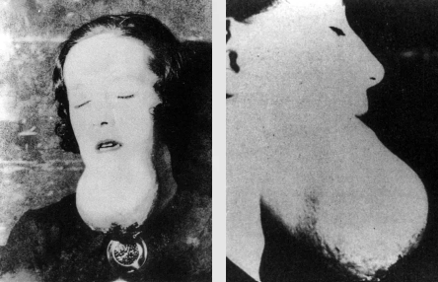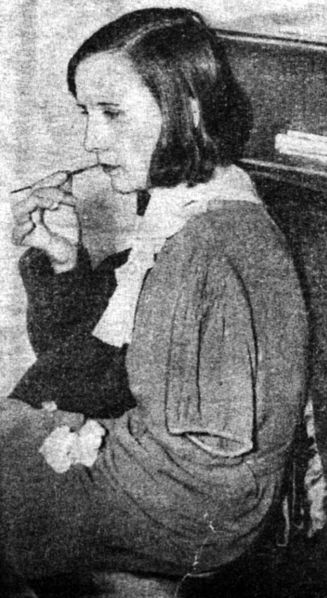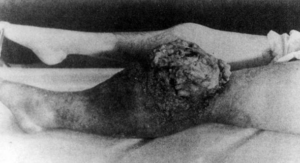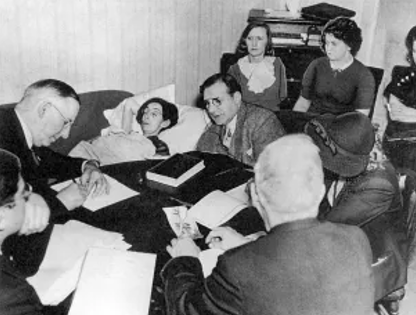April 7, 2024
The Tragedy of Irene La Porte: Deception, Tragedy, & the Legal Battle for Justice

“All I want is a taste of radium.”
This was likely a common thought among young people, young women especially, during the early twentieth century. Radium had been recently discovered by Marie Curie to be a phenomenal, enchanting, new substance. No night was complete without the allure of radium, as all girls knew that if you wanted to catch someone’s attention, you had to be stylish.1 Products made of radium, such as toothpaste, makeup, and even lingerie, were all the rage. However, these products were not easily accessible, as they were primarily marketed towards the affluent.
Regardless of the products’ exclusivity, an opportunity arose with the coming of the First World War. With the declaration of war, many women entered into the workforce. Arguably the most sought-after job for those young girls at this time lay in an exciting opportunity to work for the United States Radium Corporation. Getting paid up to three times more than the average working girl, the United States Radium Corporation was now employing women to paint numbers on watch dials with radium. An example of a week’s wage for dial-painters was $20.00, or roughly about $370 a week in today’s currency. Many of the girls applying for these jobs came from financially disadvantaged families, but soon girls who were not in active need of providing their own incomes started applying to work at the United States Radium Corporation as dial-painters just to experience what it was to be one of the glowing ghost girls.2
The only thing that these girls wanted was a chance to help provide for their families, or an opportunity to have fun and have access to something that not everyone had the luxury to afford. But every rose, no matter how beautiful and radiant, has its thorns—thorns that the United States Radium Corporation would deny punctured any skin.
It’s true that radium was being hailed as something of a miracle in the medical world, as it was known to have been the leading treatment in destroying tumors and unhealthy tissues. And there was no evidence that having contact with radium in small amounts would be lethal. At least, not yet. That did not mean that its destructive properties were not known by Dr. Sabin Arnold von Sochocky, the creator of the radium paint “Undark,” who would supply radium paint to many suppliers, including the United States Radium Corporation.3 Sochock himself had come to know the devastation that radium was capable of when he accidentally let his finger come into contact with the substance. He would later describe the affected area on the tip of his finger as if it had been chewed by a wild animal, and he elected to sever it off.4
This information, being known by the inventors of radium, however, did not affect the unsafe production practices that the United States Radium Corporation instructed its employees to follow if they wanted to do their jobs well. Proper ventilation, lead aprons, forceps, or any means of protective equipment were not provided to the dial-painters while performing their duties, and they had not even the slightest inkling that this was something that should have been required and provided for them by their employer.3

Not only were the dial-painters completely exposed to radium in their workplace, but they were also required by the United States Radium Corporation to ingest it to be able to effectively paint the radium paint onto the numbers on the watch dials. In a practice commonly referred to as the lip, dip, paint method, the dial-painters would purse the painting brush with their lips and then dip it into the radium paint to create a fine point on the brush to better paint over the numbers on the dials. Dial-painters existed all over the world in 1917, and in Europe, different methods of painting did not involve putting paint brushes to one’s mouth and exposing them to an occupational hazard.6 In doing as they were taught, dial-painters like Irene F. La Porte would ingest copious amounts of radium sulphate through the paint that was used as well as by breathing it in through the powder that flew into the air and other emanations. However, the extent to which this devastation stretched would not be acknowledged by the United States Radium Corporation until they could no longer deny it in 1924.6
Dial-painters working similar schedules as Irene La Porte would have ingested an estimated 43 micrograms of radium sulphate on a daily basis through the radium paint, working five and a half days a week.8 This would be similar to consuming the equivalent of a grain of sand of radium sulphate once a week. Even though that may seem like a small amount, it would be enough to contribute to occupational poisoning that would be fatal for those afflicted.
In 1928, Irene La Porte had a toothache. Not many knew, but this was the start of the end for her. She likely had a bad feeling in the pit of her stomach, because, like many others, this was one of the first tell-tale signs that radium poisoning was starting to set into the depths of her body. But it was too late, and no one would be able to save her body from the effects of radium.
Holding on to the small semblance of hope that she had left, she continued to visit her dentist from the onset in 1928 until 1930. Disquieted by the pains in her jaw and face, she knew now that she too was a victim of radium necrosis. The necrosis would soon spread to her legs, and then would come with an official diagnosis in the fall of October 1930.6
La Porte would voice her concerns regarding her pain to doctors, friends, colleagues, and anyone who would listen. However, her concerns were often disregarded the same way that others were turned away when they complained to both doctors and the United States Radium Corporation. Many dial-painters were told that the root cause of their symptoms was due to syphilis and that claims stating that radium was to blame were unfounded, as many medical professionals believed that radium in small quantities was beneficial for one’s health. However, in 1917, it was widely acknowledged that burns from radium could eventually lead to cancer. In 1913, it was written in various journals that radium that was not eliminated by the body would be deposited into the bones and replace the pre-existing calcium.6 This would often lead to cases of sarcoma in many of the dial-painter’s fatalities.

Despite the evidence suggesting that dial-painters who had been close to radium should take great care, the United States Radium Corporation asserted that it was not adequately informed of the dangers that radium posed, and further denied any knowledge that their employees were in harm’s way by ingesting any amount of radium sulphate during their work. Moreover, the United States Radium Corporation claimed that since they had not known about the full extent of the hazards related to radium sulphate within their workplace, they could not be fairly charged for any wrongdoing regarding occupational diseases diagnosed from 1917 to 1920.6
It took much effort for La Porte to present a claim for damages against the United States Radium Corporation, but she gathered herself and filed a suit in New Jersey against them on May 4, 1931.6 It was one of the earliest cases that attempted to gain compensation for an occupational illness.13 Many of the dial-painters working for the United States Radium Corporation found themselves afraid or unable to pursue legal action against their employer as one of the key components would be presenting evidence that they were in fact suffering a malady as a direct result of working for the company, and many doctors would not diagnose them with radium-related necrosis or radium poisoning. It was oftentimes very difficult for a dial-painter to find that she had suffered an injury, blame her employer for it, and have the means to prepare to demand compensation.14

The defendant, the United States Radium Corporation, would claim that there should be no suit and the plaintiff, La Porte, should not be entitled to compensation due to the statute of limitations having expired, rendering the plaintiff’s demand legally time-barred.
Arthur Roeder had not secured his position as head of the United States Radium Corporation without his smarts and wit. Roeder was a smart man and knew how to manipulate a situation to both his and the company’s benefit, and he was not afraid to fraudulently conceal information.15
While typically the defendant’s claim would have held up in the state of New Jersey according to Rev. 1877, p. 594, as amended P.L. 1896, p. 119, 3 Comp. St. 1910, p. 3164, § 3 6 stating that a plaintiff has up to two years to pursue legal action for damages, the United States Radium Corporation fraudulently concealed information stating that they knew about the harmful effects of radium and violated the doctrine of statutes of limitation as they impaired evidence. A perfect example of something having similarly occurred in the past was in Howard v. West Jersey Railroad Company, in which the plaintiff was seeking compensation for damages for personal injury and was led into a false sense of security by the defendant, just as the United States Radium Corporation lulled La Porte into believing that she was under no circumstances in danger in the workplace.6
In the case of La Porte v. United States Radium Corporation, La Porte presented twenty-five admissions made by expert testimony suggesting that the Corporation had knowledge that radium was hazardous since 1917. This evidence was deemed by the court to have been indisputably true, and that any literature stating that radium was not dangerous was strictly related to experimentation in the medical field.6
Thus, the court found that in the case of La Porte v. United States Radium Corporation, the defendant was guilty of committing wrongdoing and that their actions constituted legal fraud through both omission of crucial information and pursuing unethical advantages against the plaintiff.6 The court’s decision favored the plaintiffs and rejected the United States Radium Corporation’s protection under the statute of limitations.
While there’s no information publicly available regarding how much money La Porte was awarded as a result of their lawsuit, other litigants, such as Catherine Donahue making similar claims against the United States Radium Corporation, were awarded settlement amounts as high as $10,000.00 20 or roughly about $160,000.00 in 2024.
Although case law, litigation strategy, and scientific advancement have and will continue to change over time, there is much that can be learned from La Porte v. United States Radium Corporation, such as claims concerning occupational disease, personal injury, mass tort injuries, as well as the application of equitable estoppel in which concealment of information causes an individual to rely on false information, unjustly holding them to a time limit for filing and pursuing legal action.
Looking ahead, we must not forget that the pain and suffering that the dial-painters endured contributed to individuals asserting their right to sue their employers for negligence and damages incurred within the workplace. It’s crucial for companies and individuals heading companies, such as the United States Radium Corporation, to tread carefully and recognize the repercussions that can befall not just a corporation but the lives of those employed by them. This has been exemplified by the tragedy of Irene F. La Porte whose life was lost due to negligence and greed. La Porte will be honored in our sempiternal advocation for just protection and ensuring not another soul suffers the way she did ever again.
- Kathy Peiss, “Charity Girls and City Pleasures,” OAH Magazine of History 18, no. 4 (July 1, 2004): 14–16. ↵
- Kate Moore, The Radium Girls: The Dark Story of America’s Shining Women (New York: Sourcebooks, 2017), 9. ↵
- Kate Moore, The Radium Girls: The Dark Story of America’s Shining Women (New York: Sourcebooks, 2017), 17. ↵
- Kate Moore, The Radium Girls: The Dark Story of America’s Shining Women (New York: Sourcebooks, 2017), 17. ↵
- Kate Moore, The Radium Girls: The Dark Story of America’s Shining Women (New York: Sourcebooks, 2017), 17. ↵
- La Porte v. United States Radium Corporation, 13 F. Supp. 263 (Dist. Court 1935), https://law.justia.com/cases/federal/district-courts/FSupp/13/263/2096834/. ↵
- La Porte v. United States Radium Corporation, 13 F. Supp. 263 (Dist. Court 1935), https://law.justia.com/cases/federal/district-courts/FSupp/13/263/2096834/. ↵
- La Porte v. United States Radium Corporation, 13 F. Supp. 263 (Dist. Court 1935). ↵
- La Porte v. United States Radium Corporation, 13 F. Supp. 263 (Dist. Court 1935), https://law.justia.com/cases/federal/district-courts/FSupp/13/263/2096834/. ↵
- La Porte v. United States Radium Corporation, 13 F. Supp. 263 (Dist. Court 1935), https://law.justia.com/cases/federal/district-courts/FSupp/13/263/2096834/. ↵
- La Porte v. United States Radium Corporation, 13 F. Supp. 263 (Dist. Court 1935), https://law.justia.com/cases/federal/district-courts/FSupp/13/263/2096834/. ↵
- La Porte v. United States Radium Corporation, 13 F. Supp. 263 (Dist. Court 1935), https://law.justia.com/cases/federal/district-courts/FSupp/13/263/2096834/. ↵
- Kenneth A. DeVille and Mark E. Steiner, “The New Jersey Radium Dial Workers and the Dynamics of Occupational Disease Litigation in the Early Twentieth Century,” Missouri Law Review 62, no. 2 (1997): 287. ↵
- Kenneth A. DeVille and Mark E. Steiner, “The New Jersey Radium Dial Workers and the Dynamics of Occupational Disease Litigation in the Early Twentieth Century,” Missouri Law Review 62, no. 2 (1997): 286. ↵
- Kate Moore, The Radium Girls: The Dark Story of America’s Shining Women (New York: Sourcebooks, 2017), 114. ↵
- La Porte v. United States Radium Corporation, 13 F. Supp. 263 (Dist. Court 1935), https://law.justia.com/cases/federal/district-courts/FSupp/13/263/2096834/. ↵
- La Porte v. United States Radium Corporation, 13 F. Supp. 263 (Dist. Court 1935), https://law.justia.com/cases/federal/district-courts/FSupp/13/263/2096834/. ↵
- La Porte v. United States Radium Corporation, 13 F. Supp. 263 (Dist. Court 1935), https://law.justia.com/cases/federal/district-courts/FSupp/13/263/2096834/. ↵
- La Porte v. United States Radium Corporation, 13 F. Supp. 263 (Dist. Court 1935), https://law.justia.com/cases/federal/district-courts/FSupp/13/263/2096834/. ↵
- Kate Moore, The Radium Girls: The Dark Story of America’s Shining Women (New York: Sourcebooks, 2017), 235. ↵
Tags from the story
#La Porte
#Occupational Disease
#Personal Injury
#Radium
#Radium Girls
#United States Radium Corporation
Law

Haley Aleman
Haley is a researcher and Political Science Major at St. Mary’s University. She enjoys understanding and learning legal processes and shedding light on the importance of civic engagement.
Nelson Wolf Program
STMU 24′
Recent Comments
Leaya Valdez
The topic of radium usage in America has always been such a interesting subject for me and after reading this article and hearing Irene La Porte’s story and her experience and life after working with radium is one that that i think many people should read about. This article was very well written and thought out because it captured important information while also giving us the history of radium usage.
26/04/2024
3:06 pm
Martin Martinez
This reminds me very much of “The Jungle” by Upton Sinclair. Although highlighting unsanitary practices in meat packaging was not its initial goal, people nonetheless called for better standards once they caught wind of negligence. It is sad to hear that watch painters were neglected like this too, but I am relieved that people have called for better standards.
26/04/2024
3:06 pm
qmero
Irene La Porte’s story is humbling to learn about. Her fate, along with other dial-painters, and consumers of radioactive products, highlights the consequences of corporate negligence and greed. The disregard for the safety of employees led to terrible suffering and loss of life. La Porte’s story is a tragic example of the importance of workplace safety legislation and the need to hold corporations accountable for their actions.
23/04/2024
3:06 pm